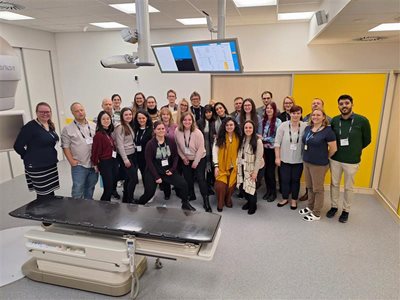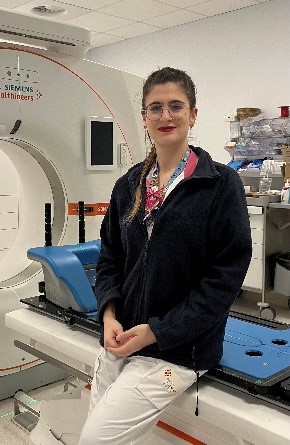Prague, Czech Republic, 23-24 November 2024
COURSE DIRECTOR
Sophie Perryck, radiation therapist, University Hospital Zurich, Switzerland
Hello! My name is Filipa Santos and at the moment I am working at the Jules Bordet Institute in Brussels, Belgium. After two years of working as a radiation therapist, I decided to enrol on this course to widen my knowledge by gaining a better understanding of the state-of-the-art regarding positioning and immobilisation. This was my first ESTRO course and it exceeded my expectations in both intellectual and social fields.
The course addressed several topics. Examples are how the comfort of the patients impacts their treatment; the guidelines on how to execute stereotactic body radiation therapy (SBRT) treatment; and what kind of positioning and immobilisation devices should be chosen, with consideration of the need to adapt the chosen equipment to the type of treatment and the comfort it provides to the patient. An important part of the course was the workshops, at which it was possible to discuss with other participants our different ways of working and to show, for example, our different ways of making thermoplastic masks for use in head-and-neck treatment.
From my point of view, the most important points to take from the course were:
- the patient’s comfort is more important than most people think when it comes to choosing the right immobilisation and positioning device for the treatment; and
- it is important to adapt the method of immobilisation to the type of treatment and to try to understand in what manner it impacts the success of the treatment.
For example, regarding positioning, one of the speakers discussed the advantages of the use of deep-inspiration breath-hold (DIBH) in SBRT treatments compared with the performance of the treatment with free breathing, given that with the use of the DIBH technique, it is possible to achieve a more stable position of the tumour. I think it will be interesting to try to implement the DIBH technique in my service since we are testing the use of treatments in which no tattoos are used on the patients. I also learned about the use of a vacuum bag to position and immobilise the patient during the treatment of limbs. This could be very useful in my practice because I learned that the use of such a bag with a thermoplastic masque could almost guarantee that the patient would remain still.

In general, attendance at the course was a great experience and I really recommend it to all therapists who seek to improve their knowledge of the correct positioning of a patient and what technique to use according to the type of treatment given.

Filipa Santos
Radiation therapist
Jules Bordet Institute
Brussels, Belgium